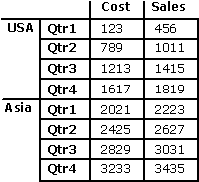Using Measures on the COLUMNS Axis
| OLE DB Programmer's Reference |
In the special case of a dataset consisting of only the Measures dimension along the x-axis, the resulting flattened view is typical of the way in which atomic multidimensional data is commonly stored in a relational database. This table of granular data is called a fact table. The combination of a fact table and a set of related dimension tables make up a star schema configuration.
For example, consider the following MDX statement. (Unqualified names are assumed to be unique.)
SELECT {Sales, Cost} ON COLUMNS, CROSSJOIN({USA, Asia}, {Qtr1, Qtr2, Qtr3, Qtr4}) ON ROWS FROM SalesCube WHERE ([1991], Computers) This produces the following dataset:

In turn, this dataset yields the following flattened rowset:
| [Continents].[MEMBER_CAPTION] | [Countries].[MEMBER_CAPTION] | [Quarters].[MEMBER_CAPTION] | [Measures].[Cost] | [Measures].[Sales] |
|---|---|---|---|---|
| North America | USA | Qtr1 | 123 | 456 |
| North America | USA | Qtr2 | 789 | 1011 |
| North America | USA | Qtr3 | 1213 | 1415 |
| North America | USA | Qtr4 | 1617 | 1819 |
| Asia | NULL | Qtr1 | 2021 | 2223 |
| Asia | NULL | Qtr2 | 2425 | 2627 |
| Asia | NULL | Qtr3 | 2829 | 3031 |
| Asia | NULL | Qtr4 | 3233 | 3435 |
This representation is intuitive and corresponds to the way in which such data is usually displayed in a tabular view.
This example also illustrates step 2 of the algorithm in the section "Flattening Algorithm": If the DIMENSION PROPERTIES clause is not specified, it is equivalent to specifying DIMENSION PROPERTIES MEMBER_CAPTION.
1998-2001 Microsoft Corporation. All rights reserved.
EAN: 2147483647
Pages: 1083